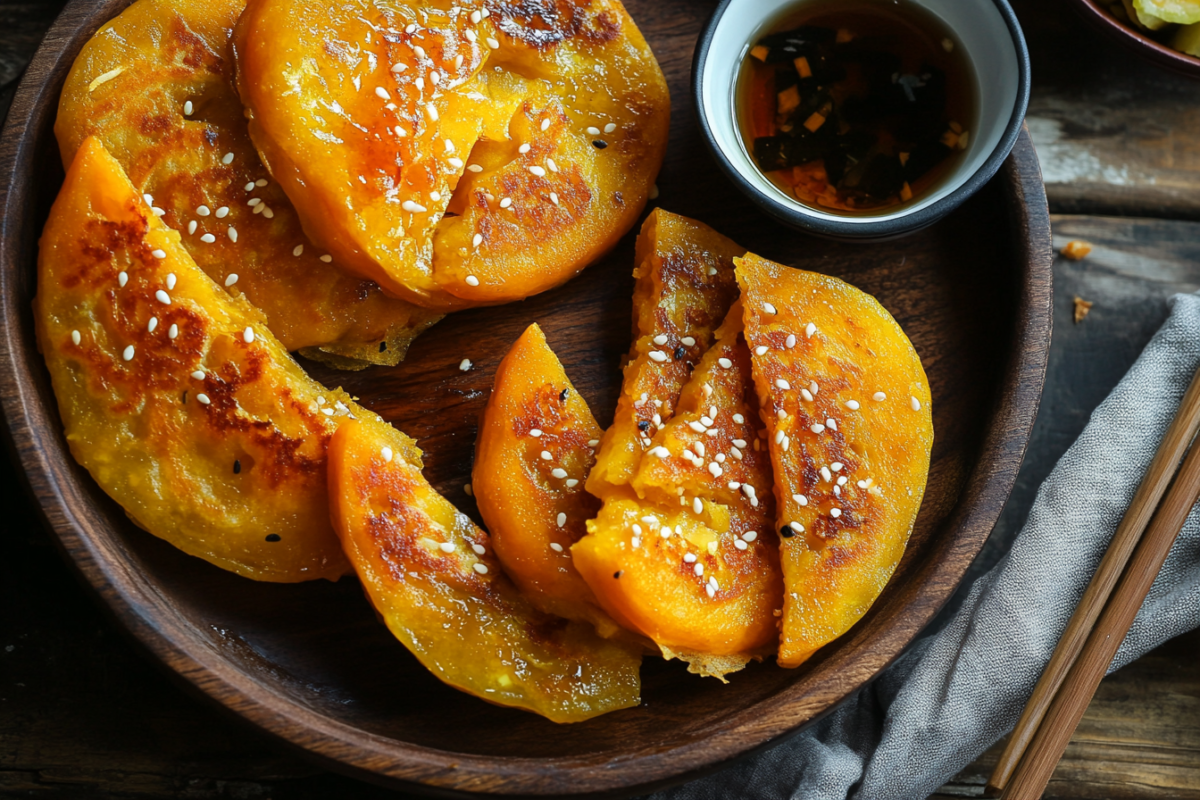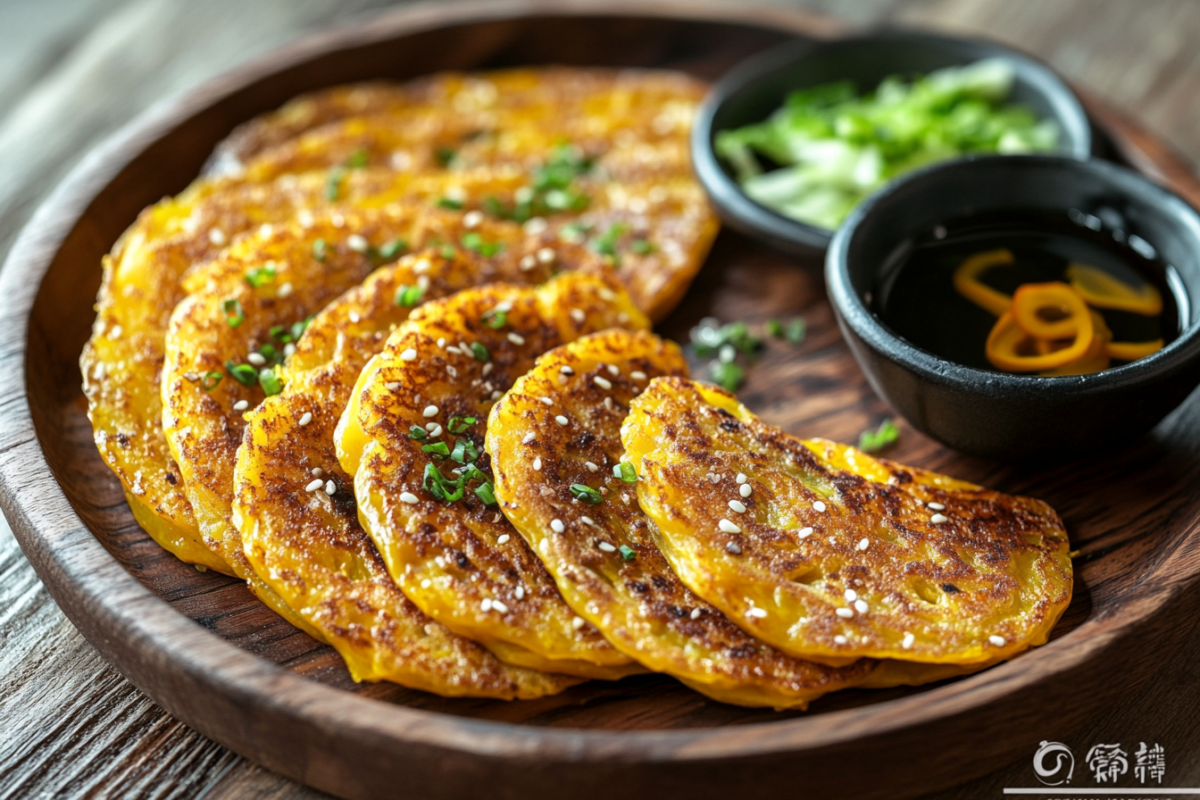When you think of Asian pumpkin recipes, what comes to mind? Perhaps a steaming bowl of spicy Thai pumpkin curry, or a creamy, comforting bowl of hobakjuk (Korean pumpkin porridge)? From rich curries to savory soups and sweet desserts, pumpkins have a special place in many Asian cuisines. They’re not just delicious but also incredibly versatile, offering a natural sweetness and earthy flavor that perfectly complements a wide range of ingredients, from coconut milk to fresh herbs and aromatic spices.
In this article, we’ll dive into 10 must-try Asian pumpkin recipes, each brimming with flavor and nutritional benefits. Whether you’re a seasoned cook or just exploring new flavors, there’s something here to inspire your next meal. But before we jump into the recipes, let’s take a closer look at the role of pumpkins in Asian dishes and what makes them such a staple ingredient in this part of the world.
The Role of Pumpkins in Asian Cuisine
Why Pumpkins Are a Staple in Asian Kitchens
In Asia, pumpkins aren’t just ingredients – they play a key role in history, culture, and tradition. Throughout the continent, cooks have used pumpkins for centuries in a wide variety of dishes, from soups to sweets. Many Asian countries associate pumpkins with abundance and prosperity, often featuring them during festivals and important events. Their versatility in both savory and sweet applications makes them a prized ingredient in kitchens.
Besides their cultural importance, pumpkins offer impressive nutritional benefits. They’re packed with vitamins A, C, and E, along with fiber, which helps support vision, boost immunity, and promote healthy digestion. The high antioxidant content in pumpkins, especially carotenoids, helps reduce inflammation and protect the body from oxidative stress. With their naturally sweet flavor, pumpkins not only enhance the taste of dishes but also add a healthy, nutritious element to the meal.
Popular Varieties of Pumpkins Used in Asia
Asian cuisines feature numerous pumpkin varieties, each offering its own unique texture and flavor. For example, the kabocha pumpkin, also known as Japanese pumpkin, remains a favorite in Japan. Its dense, sweet flesh works wonderfully in savory stews, tempura, or even when roasted to perfection. The rich flavor of kabocha often makes it the star of recipes, where it pairs with miso or forms the base of delicious, comforting curries.
In addition to kabocha, the butternut squash is popular in Indian and Southeast Asian dishes. Its creamy texture and mild sweetness complement aromatic spices like cumin, coriander, and turmeric. In other regions, cooks prefer the calabaza variety, often used in Filipino cooking. This variety pairs well with coconut milk for hearty stews like ginataang kalabasa.
Top 10 Asian Pumpkin Recipes
Top 10 Must-Try Asian Pumpkin Recipes
Pumpkin is an ingredient that works wonders in a variety of dishes, whether savory or sweet. In this section, we’ll explore 10 must-try Asian pumpkin recipes, each bursting with rich flavors and cultural significance. Whether you’re looking to warm up with a comforting soup or satisfy your sweet tooth with a delightful dessert, you’ll find the perfect recipe to bring some pumpkin magic into your kitchen.
1. Thai Pumpkin Curry
One of the most beloved Asian pumpkin recipes comes from Thailand – the Thai pumpkin curry. This dish is famous for its rich, creamy texture, thanks to the use of coconut milk, which balances the natural sweetness of the pumpkin. Typically paired with aromatic herbs like lemongrass, ginger, and kaffir lime leaves, this curry is a burst of flavors. The pumpkin absorbs the spicy-sweet curry sauce, creating a dish that’s perfect when served with a bowl of steamed rice.
What makes this dish popular is its ability to combine savory and sweet elements, making it a crowd-pleaser for any occasion. The richness of the coconut milk combined with the pumpkin’s natural sweetness is nothing short of comforting.
2. Chinese Pumpkin Pancakes
Chinese pumpkin pancakes make a delightful savory snack that pairs perfectly with a cup of green tea. To prepare them, mix mashed pumpkin with flour, sugar, and a touch of sesame oil. The pancakes turn crispy on the outside and soft on the inside. You can add sweet red bean paste or savory fillings like green onions to create a balanced flavor profile.
Chinese pumpkin pancakes are often served as a breakfast or street food in China. Traditionally, people pair them with pickled vegetables or a dipping sauce made from soy sauce and vinegar, which adds a tangy kick to the dish.
3. Korean Pumpkin Porridge (Hobakjuk)
Hobakjuk, or Korean pumpkin porridge, is a comforting dish that Koreans often enjoy during colder months or when feeling under the weather. To make this dish, simmer pumpkin until soft and then blend it into a smooth, velvety soup. Hobakjuk has a naturally sweet flavor and is easy to digest.
Koreans love hobakjuk for its soothing texture and mild flavor. They typically garnish the porridge with sesame seeds or drizzle some sesame oil on top to add a touch of nuttiness to each spoonful. This simple yet nourishing dish serves as a go-to comfort food in Korea.
4. Japanese Kabocha Tempura
For a crispy treat, look no further than Japanese kabocha tempura. Slice kabocha pumpkin and coat the pieces in a light, crispy batter before deep-frying them to perfection. The key to making perfect tempura lies in the batter – it should be thin and airy, allowing the sweetness of the pumpkin to shine through without overpowering it.
Typically, tempura comes with a dipping sauce made from soy sauce, mirin, and dashi. This sauce adds a savory umami punch to the sweet kabocha. The golden, crunchy exterior contrasts beautifully with the tender pumpkin inside, making each bite irresistibly delicious.
5. Indian Spiced Pumpkin Soup
Pumpkin plays an essential role in Indian cuisine, especially when paired with aromatic spices like cumin, coriander, turmeric, and garam masala. Indian spiced pumpkin soup combines these flavors in a creamy, satisfying bowl of comfort. The natural sweetness of the pumpkin balances perfectly with the warmth of the spices.
In India, people often serve this soup with naan bread or crispy papadums, adding texture to the rich, velvety soup. It’s a warming dish that’s perfect for cool evenings and can easily become vegan by using coconut milk.
6. Pumpkin Fried Rice
Pumpkin fried rice is a delightful fusion dish that combines the best of sweet and savory flavors in Asian cuisine. Sauté pumpkin until tender, then mix it with rice, vegetables, and soy sauce. Some variations include protein, such as tofu or chicken, to make it a more filling meal.
This dish is a great way to use leftover rice and can be made in a flash. The sweetness of the pumpkin contrasts beautifully with the saltiness of the soy sauce, creating a mouthwatering combination. Finish it off with a sprinkle of green onions, and you’ve got a quick and flavorful meal.
7. Filipino Pumpkin and Coconut Milk Stew (Ginataang Kalabasa)
In the Philippines, ginataang kalabasa is a beloved dish that combines pumpkin with coconut milk to create a rich, hearty stew. The creamy coconut milk complements the pumpkin’s sweetness, while garlic, onion, and ginger provide a savory base. People often make this dish with shrimp, chicken, or fish to add protein and balance the flavors.
Ginataang kalabasa typically comes with rice, making it a filling and satisfying meal. The richness of the coconut milk and the natural sweetness of the pumpkin make this dish a crowd-pleaser, especially for those craving comfort food.
8. Vietnamese Pumpkin Soup
Vietnamese pumpkin soup is a fresh, light dish perfect for those who enjoy brothy soups with a burst of flavor. To make it, simmer pumpkin with ginger, lemongrass, and a variety of herbs like cilantro and mint. The result is a fragrant, sweet-savory broth with tender pumpkin pieces floating in it.
This dish often serves as an appetizer or side dish, providing a refreshing contrast to heavier entrees. The fresh herbs enhance the dish’s aromatic appeal, making it as delicious as it is healthy.
9. Malaysian Pumpkin Rendang
Malaysian pumpkin rendang offers a delightful twist on the traditional beef rendang. In this version, pumpkin simmers slowly in a rich coconut milk base along with bold spices like turmeric, cumin, and cinnamon. The result is a flavorful, melt-in-your-mouth stew that combines the sweetness of pumpkin with the deep, earthy flavors of Malaysian rendang.
Though traditionally made with beef, pumpkin rendang works just as well as a vegetarian-friendly alternative to the classic dish.
10. Sweet Pumpkin Dessert Recipes
In many Asian cuisines, pumpkin is used to create delightful desserts that highlight its natural sweetness. One popular treat is pumpkin mochi, a chewy, sticky rice cake filled with sweetened pumpkin paste. Another favorite is pumpkin sesame balls, which are crispy on the outside and filled with sweet pumpkin and sesame paste.
These desserts are enjoyed year-round, often during festivals and special occasions, and provide a perfect ending to any meal. The balance of sweet and savory in these treats offers a unique way to savor the flavor of pumpkin in a dessert form.
Tips for Cooking with Pumpkins
Tips for Preparing and Cooking Pumpkins
Whether you’re new to cooking with pumpkins or a seasoned pro, knowing how to properly prepare and cook them is key to creating the best Asian pumpkin recipes. In this section, we’ll share some valuable tips on selecting the right pumpkin, storing it, and preparing it for various cooking methods. By following these guidelines, you’ll ensure that your pumpkin dishes are as fresh and flavorful as possible.
Selecting the Right Pumpkin
When it comes to selecting the perfect pumpkin, the variety you choose will depend on the type of Asian recipe you’re preparing. For example, if you’re making a Japanese dish like kabocha tempura, look for a firm, deep-green kabocha pumpkin. Kabocha has a naturally sweet, creamy texture that makes it perfect for tempura or curries. If you’re planning to make a Thai pumpkin curry, you can opt for a small to medium-sized pumpkin with a dense flesh that will hold up well in the curry sauce.
In general, choose pumpkins that feel heavy for their size and have a smooth, blemish-free skin. A good pumpkin should also have a deep color—bright orange for varieties like the butternut squash, or a deep green for kabocha. Avoid pumpkins with soft spots or cracks, as these may indicate that the pumpkin is past its prime.
Storage Tips
Storing pumpkins properly can prolong their shelf life and help maintain their flavor. Whole pumpkins should be stored in a cool, dry place away from direct sunlight. A pantry or cellar with a temperature of 50-55°F (10-13°C) is ideal. When stored this way, pumpkins can last for weeks, sometimes even up to a month, depending on the variety.
Once you’ve cut the pumpkin, you’ll want to store the remaining pieces in the fridge. Wrap them in plastic wrap or place them in an airtight container to keep them fresh for up to 5-7 days. If you need to store cooked pumpkin for later use in Asian recipes, it can be kept in the refrigerator for about 3-4 days. For longer storage, consider freezing your pumpkin. Simply puree or cube the pumpkin and store it in freezer bags for up to 6 months.
Prepping and Cooking Techniques
When preparing pumpkins for cooking, the first step is often cutting and peeling. To peel a pumpkin, it’s easiest to use a sharp vegetable peeler or a knife. For tougher varieties like kabocha, you might want to soften the pumpkin by microwaving it for a few minutes, making it easier to cut through the skin.
After peeling, you can either cube the pumpkin for curries, soups, or stir-fries or puree it for dishes like hobakjuk (Korean pumpkin porridge) or pumpkin desserts. To cook pumpkin for these dishes, you can steam, boil, roast, or sauté it. Roasting pumpkin in the oven is a great way to bring out its natural sweetness, while steaming or boiling it helps preserve its nutrients.
For dishes like pumpkin fried rice or pumpkin tempura, you may want to slice the pumpkin into thin wedges or bite-sized cubes to ensure even cooking. If you’re making a creamy soup or curry, blending the pumpkin will give you that silky smooth texture that makes these dishes so comforting.
Nutritional Benefits of Asian Pumpkin Recipes
Why You Should Add Asian Pumpkin Recipes to Your Diet
Incorporating Asian pumpkin recipes into your diet is not only a delicious way to explore different cuisines but also a fantastic way to boost your health. Pumpkins are loaded with essential vitamins and minerals such as vitamin A, which is crucial for vision health, and vitamin C, which supports immune function. Additionally, pumpkins are rich in fiber, which promotes healthy digestion and helps manage weight.
The antioxidants in pumpkins, including carotenoids like beta-carotene, contribute to reducing inflammation and protecting your cells from oxidative damage. This makes pumpkin dishes beneficial for overall heart health as well.
Furthermore, the low-calorie content of pumpkins makes them an excellent choice for anyone looking to maintain a healthy diet. Whether it’s a spicy Thai pumpkin curry or a Korean pumpkin porridge, you can enjoy these nutrient-packed dishes guilt-free.
Adding pumpkin to your meals is a tasty and nutritious way to support your health, making Asian pumpkin recipes a valuable addition to your regular diet.
Frequently Asked Questions About Asian Pumpkin Recipes
What type of pumpkin is best for Asian recipes?
The type of pumpkin you choose depends on the recipe you’re making. For Japanese dishes, kabocha pumpkin is preferred for its creamy texture and sweetness. For Thai and Southeast Asian curries, you can use any dense, firm pumpkin variety like butternut squash or even local varieties depending on availability. If you’re making a sweet dessert, calabaza or pie pumpkins are often used for their sweet flesh.
Can I use canned pumpkin for Asian dishes?
While fresh pumpkin is often recommended for its flavor and texture, you can substitute canned pumpkin in many recipes. Just make sure to choose unsweetened canned pumpkin to avoid altering the flavor. If you’re using canned pumpkin in Asian recipes, be sure to adjust the cooking time, as it’s already soft and may require less cooking.
Are Asian pumpkin recipes gluten-free?
Many Asian pumpkin recipes are naturally gluten-free, especially those that rely on pumpkin, coconut milk, and spices. However, you should always double-check ingredients like soy sauce, which may contain wheat. To make sure your dishes are gluten-free, look for gluten-free soy sauce or tamari.
How can I make vegan versions of Asian pumpkin recipes?
Making vegan versions of Asian pumpkin recipes is simple! Replace any animal-based ingredients, like meat or dairy, with plant-based alternatives. For instance, swap coconut milk for cream or use tofu as a protein substitute in curries and stews. Vegan versions of pumpkin desserts can be made by using plant-based sweeteners and egg replacements like flaxseed or chia seeds.
What are the most popular Asian pumpkin desserts?
Popular Asian pumpkin desserts include pumpkin mochi, a chewy rice cake filled with sweet pumpkin paste, and pumpkin sesame balls, which are crispy on the outside with a sweet pumpkin and sesame filling. In many Asian countries, pumpkin is also used in custards, cakes, and sweet soups, often paired with ingredients like coconut milk and sesame paste for added richness.
Conclusion and Call to Action
As we’ve seen, Asian pumpkin recipes offer a delightful combination of flavor, versatility, and health benefits. Whether you’re preparing a savory dish like Thai pumpkin curry or indulging in a sweet treat like pumpkin mochi, pumpkins can enhance any meal. With their rich nutritional profile, they’re an excellent choice for boosting immune health, supporting vision, and promoting heart health.


